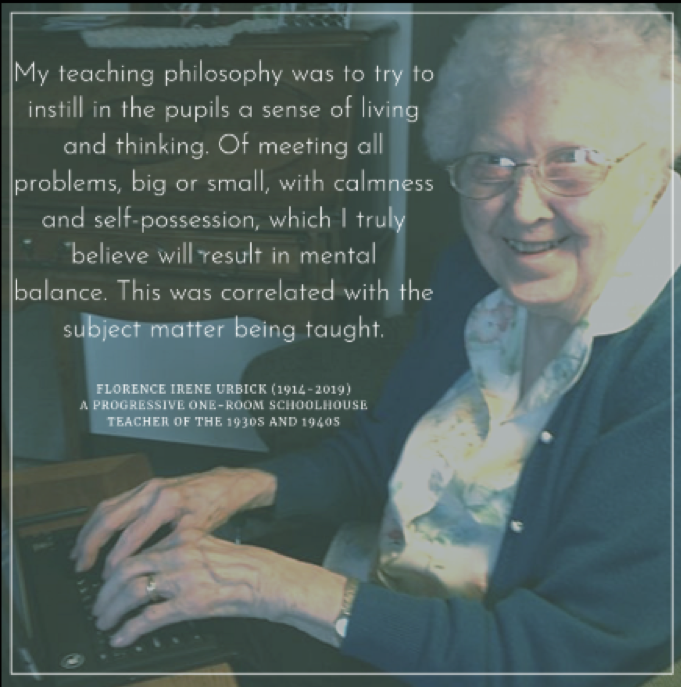Weaving Social and Emotional Learning (SEL) into Your Teaching Practices
CategoriesMy grandmother, a former teacher, recently passed away (July 11, 2019) - living a full and active life of 105 years. She was my inspiration for becoming a teacher, and we had a countless number of conversations about teaching and how things have changed from then to now. (She taught in a one-room schoolhouse in rural Wisconsin in the 1930s and 1940s.)
I saved every beautifully handwritten letter and card she sent me, and I have a special folder in my email account filled with every message from her. (I taught her how to use the Internet when she was 94, and she was seen using her iPad nearly until the day she died. You can read more about my tech-savvy grandmother in this blog post that I wrote last year – 3 Teaching Practices of the 1930s Reimagined: Using Technology in the Classroom.)
I always knew she was well ahead of her time, but as I was cherishing the memories last week by rereading some of her emails, I stopped in my tracks. In one particular email she shared her teaching philosophy with me:

My teaching philosophy was to try to instill in the pupils a sense of living and thinking. Of meeting all problems, big or small with calmness and self-possession, which I truly believe will result in mental balance. This was correlated with the subject matter being taught.
-Florence Urbick (1914-2019)
Life skills, critical thinking, problem-solving, self-awareness, self-management, mental health…her teaching philosophy was based on social and emotional learning (SEL), decades before it was known as SEL!
Grandma Florence had nearly 40 students on any given year, ranging from grades 1 through 8. Her duties also included keeping the school clean (no custodian on duty) and building fires on cold Wisconsin days to keep the school warm – she had a full schedule!
In one email, she stated, “We were sure to have all the lessons (reading, penmanship, history, geography, spelling, and some art and music) every day because the Superintendent of Schools would sometimes come without notifying us.”
She didn’t have time for separate lessons to support the social and emotional learning needs of her students, so as stated in her philosophy – “This was correlated with the subject matter being taught.” THIS is exactly what the educators and I in Social and Emotional Learning: Promoting Positive Mental Health Across the Curriculum talk about in the course!
I don’t know exactly how Grandma Florence specifically correlated SEL into her teaching practices, but I imagine she set a positive example for her students with her calm and caring nature, her positive attitude, and her growth mindset. I know she also fostered relationships among her students by encouraging them to work together on academic skills and life skills. She also reserved a full hour of the schedule every day for lunch and recess to build relationships and to stay active. Below are a few excerpts from her emails:
The older pupils would help the younger ones a lot, and they loved it. Sometimes I would let them go in the hallway to do so because of the interruptions from the class being held in the front of the room. How anyone learned anything in that small classroom, with the commotion there was at times, is quite unbelievable.
The pupils had certain jobs to do each day – to see that the water jug was filled with fresh water; raise and lower the flag, fold it, and bring it in each day; to see that there was enough firewood in the wood box for the next day, and to keep the outdoor privies (bathrooms) as clean as possible.
…Then at 12:00, we had a noon break, eating our lunch together and getting outside for fun and exercise until 1:00. After a few years, we were given some food from the government, which helped the children enjoy their meal more.
-Florence Urbick (on teaching in a one-room schoolhouse in the 1930s – 1940s)
Perhaps you’re feeling inspired and wondering how you will weave SEL into your own modern-day teaching practices. Here are a few ideas recently shared by educators in Social and Emotional Learning: Promoting Positive Mental Health Across the Curriculum:
Andy, a high school social studies teacher, uses self-reflection with his students to have them think about how they prepared for a unit of study and what they will do differently the next time. “For many, it is beneficial to realize they are in control of their learning.” Andy also shared that he will use class discussions about current events as an opportunity for students to consider how the events are impacting them emotionally.
Sara, an elementary band and music teacher has integrated the pillars of the Character Counts program (trustworthiness, respect, responsibility, fairness, caring, and citizenship) into a musical called “Choices Count!”
Jackie, a middle school special education math teacher, incorporates self-management skills such as: encouraging students to take a break when they feel frustrated, deep breathing exercises, and the use of stress balls. She plans to implement more group work and collaboration to further support the SEL needs of her students.
Toni, a high school special education teacher, works hard to build relationships with her students from day one. “By getting to know my students, I have the ability to learn why students feel the way they do about school, giving me a more personal connection with each individual student.”
Stacy, a third-grade teacher makes connections with her students by hosting monthly lunch dates in her classroom. After recess, the students bring their lunches to the classroom where they sit at a special table to eat, visit, and share special things about themselves. Stacy noted, “I know that my students come to treasure these lunch dates just as I do because they talk about them for years after when they see me.”
On my grandma’s 103rd birthday, she wrote, “I just can’t believe I’m still here on Earth. There are still some things I do want to see, like a better world for my descendants, which is a pretty big order.”
A big order, indeed, but perhaps sprinkling a little more SEL into the classroom curriculum is just what our students need to prosper in our world. Please share how you implement SEL into your teaching practices – we’d love to hear your ideas!
Here are a few classes related to this topic:
 ADHD: Teaching and Learning Strategies
ADHD: Teaching and Learning Strategies
 Diversity, Equity, Inclusion, and Belonging (DEIB) in Education
Diversity, Equity, Inclusion, and Belonging (DEIB) in Education
 Sheltered English Immersion (SEI): Best Practices for English Learners
Sheltered English Immersion (SEI): Best Practices for English Learners